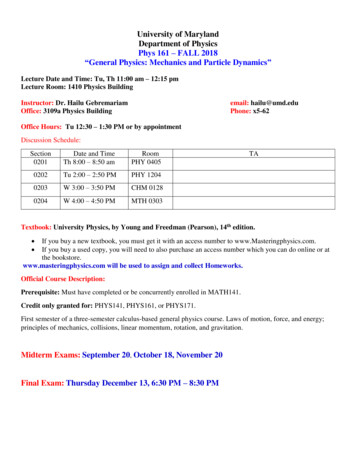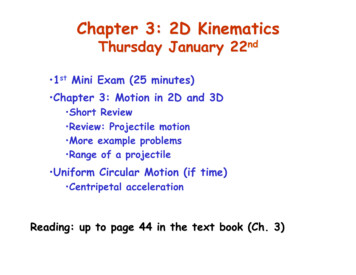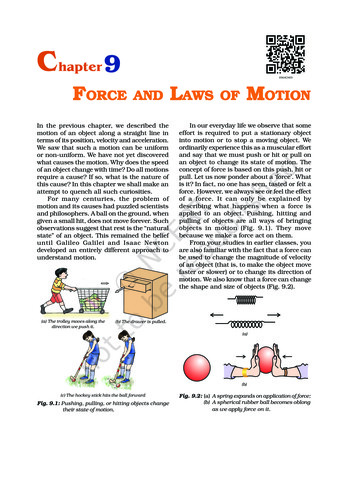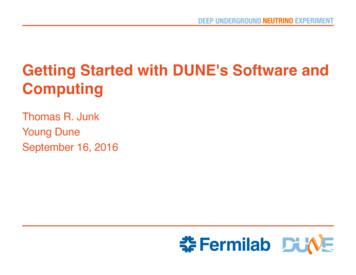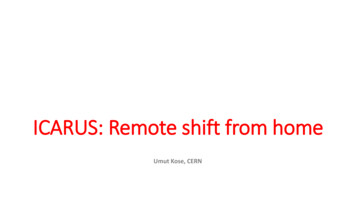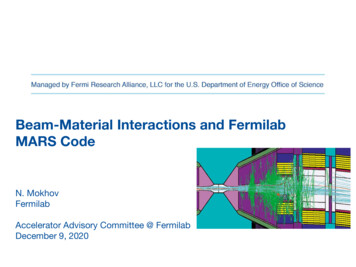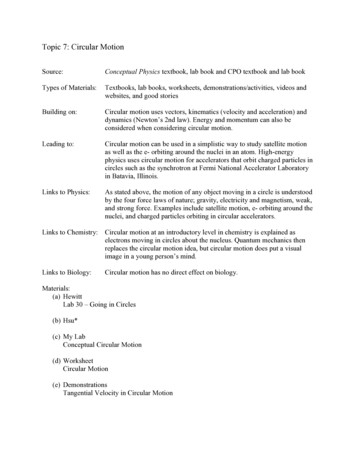
Transcription
Topic 7: Circular MotionSource:Conceptual Physics textbook, lab book and CPO textbook and lab bookTypes of Materials:Textbooks, lab books, worksheets, demonstrations/activities, videos andwebsites, and good storiesBuilding on:Circular motion uses vectors, kinematics (velocity and acceleration) anddynamics (Newton’s 2nd law). Energy and momentum can also beconsidered when considering circular motion.Leading to:Circular motion can be used in a simplistic way to study satellite motionas well as the e- orbiting around the nuclei in an atom. High-energyphysics uses circular motion for accelerators that orbit charged particles incircles such as the synchrotron at Fermi National Accelerator Laboratoryin Batavia, Illinois.Links to Physics:As stated above, the motion of any object moving in a circle is understoodby the four force laws of nature; gravity, electricity and magnetism, weak,and strong force. Examples include satellite motion, e- orbiting around thenuclei, and charged particles orbiting in circular accelerators.Links to Chemistry: Circular motion at an introductory level in chemistry is explained aselectrons moving in circles about the nucleus. Quantum mechanics thenreplaces the circular motion idea, but circular motion does put a visualimage in a young person’s mind.Links to Biology:Circular motion has no direct effect on biology.Materials:(a) HewittLab 30 – Going in Circles(b) Hsu*(c) My LabConceptual Circular Motion(d) WorksheetCircular Motion(e) DemonstrationsTangential Velocity in Circular Motion
(f) Websites and Videos1. GPS Lab Sim Activity (Shockwave)2. ESPN SportsFigures “Walking on Water” (Water Skiing)3. The G-Force ExperienceFunderstanding & Question 3-D Coaster Lab Sim (Shockwave/Java)(g) Good StoriesCircular Motion and the “Funky Chicken”
Topic 7: Lab – Circular Motion, Conceptual 2Purpose:Spin a mass and:(a) Discover what physical factors affect the inward centripetal force keeping the mass “inorbit.”(b) Determine if those factors directly or indirectly (inversely) affect that inward force.ClockSpinningStopperStringMeter StickSpring ScaleProcedure:(a) How does velocity affect centripetal force?1. Securely attach one end of a 1.5 m strong, thin, braided string to a #5 one-hole rubberstopper.2. Cut a 15 cm long by 1/4” inner diameter hollow glass tube and fire polish each end tomake them smooth.3. Duct tape the glass tube to a meter stick leaving 1 cm above the 0 cm end of the meterstick.4. Thread the string through the top of the glass tube and create a permanent loopabout 2 cm in diameter.5. Attach a spring scale calibrated in Newton’s (0-5 N or 0-20 N depending on the trial)to the loop.6. Hold this apparatus as shown in the sketch with your most coordinated hand at the topof the meter stick and glass tube.7. Hold tight and rotate in small horizontal circles at a constant rate.8. Now adjust that rate using a radius of 60 cm to 10 revolutions in 5 seconds (2 rev/s).Record your centripetal force and velocity in the table.9. Repeat at 60 cm, but do 15 revolutions in 5 seconds (3 rev/s). Record.10. Now repeat at 60 cm, but do 20 revolutions in 5 seconds (4 rev/s). Record.11. Sketch a force-velocity graph and from the shape of the graph determine the mathrelationship between force and velocity.
Data:Frequency (representing velocity)(Rev/s)Centripetal Force(N)(a)(b)(c)Force-Velocity GraphFFVAnalysis:Centripetal force is affected by velocity in the following way:
(b) How does mass affect centripetal force?1. Horizontally spin one #5 single hole stopper at a radius of 60 cm at 10 revolutions in5 seconds (2 rev/s). Record the centripetal force below.2. Remove the string from the glass tube and thread a second #5 stopper onto the string.Again, at 60 cm radius and 2 rev/s, spin the double mass. Make sure to keep theradius at 60 cm (think). Record.3. Repeat step 11, but with three stoppers.Data:Mass (Stopper)(a)1(b)2(c)3Centripetal Force (N)Force-Mass GraphM
Analysis:How does the mass affect the centripetal force needed to maintain circular motion?(c) How does the radius affect centripetal force?1. Use one #5 stopper. Rotate the one-hole stopper at a radius of 60 cm at 10 revolutionsin 5 s (2 rev/s). Record below.2. Change the radius to 30 cm, but keep the same velocity. Thus, at 30 cm radius youwill have to rotate at 4 rev/s (if the circumference halves then so must the time torevolve). Record the values below.3. Change the radius to 20 cm, but keep the same velocity. Thus, at 20 cm radius, youwill have to rotate at 6 rev/s (if the circumference is 1/3 as much, then the time mustbe 1/3 as much). Record the values below.Data:Radius (M)Centripetal Force (N)(a)(b)(c)
Force vs. 1/R GraphRAnalysis:How does the radius affect the centripetal force needed to maintain circular orbit?Summary:Combine all three analyses from (a), (b), and (c) in a mathematical form to show how velocity,mass and radius affect centripetal force.
Topic 7: Lab – Circular Motion Answer Sheet(a) Data: (SAMPLE) – Force vs. VelocityVelocity234Force4916Force vs. Velocity234VAnalysis:The centripetal force increases faster than the velocity, suggesting that a power law might beat work such as F ! V2. (This is correct.)(b) Data: (SAMPLE) – Force vs. MassMass123Force4812Force vs. Mass Graph123
Analysis:The centripetal force increases directly with the mass (F ! M).(c) Data: (SAMPLE) – Force vs. RadiusCentripetal Force4812Radius603020Force vs. 1/R Graph204060RAnalysis:As the radius gets smaller, the force gets larger when keeping the same velocity. This is aninverse relationship or also called an indirect relationship and can be written as F ! 1/R.Summary:The centripetal force is affected by velocity as the square of the velocity, and affected directly bythe mass, and inversely affected by the radius.
Topic 7: Worksheet – Circular MotionA. Linear Speed, Tangential Speed and Rotational (Angular) Speed:OabYou ride this merry-go-round and firststand at point (a) and then at point (b)and rotate counterclockwise. Point (a) ishalfway between the center, O, and theouter edge (b) of the bar that you holdon to.1. How does the time of one rotation compare for point (a) and point (b)?2. What is the shape of the path for points (a) and (b) during one rotation?3. How does the distance traveled by you at points (a) and (b) compare for one rotation?4. How would your linear speeds compare at points (a) and (b)? (Linear speed is distancetraveled divided by the time of travel.)5. Is your direction of motion at (a), parallel or perpendicular to the bar? So as pictured,your direction of motion is: back, to the right, to the left or forward?6. Is this rotational motion when direction is included, a scalar or vector?7. If the motion at (a) or (b) includes rate and direction, should this motion be called(a) radial (out from the center) speed, (b) radial velocity, (c) tangential speed, or(d) tangential velocity?
Rotational speed for a rotating object is measured by the angle moved through (sweepout) divided by the time to rotate that angle. Rotational angles can be measured bydegrees, revolutions (rotations), and radians. One time around a circle is measured inunits of 360 degrees, 1 revolution or 2 ! radians. For now, we will use revolutions.8. If you stand at point (a) and move through 5 revolutions in 10 seconds, your rotationalspeed is equal to:9. If you stand at point (b) and move through 5 revolutions in 10 seconds your rotationalspeed is equal to:10. As you move from the center of the rotating merry-go-round to the outside, your linearspeed and your rotational speed .B. Centripetal Force and Centrifugal ForceCentripetal force is defined as an inward force on a body that causes it to move in circles.Centrifugal force is defined as an outward force on a body that “appears real” to the bodyrotating in a circle, however, it is fictitious (fake).11. What is the type of force exerted on you by the bar at points (a) and (b) thatkeep you moving in a circle?12. When the merry-go-round is turning and you let go at point (a) or (b), you see yourselfflying out from the merry-go-round. From someone’s point of view nearby the merry-goround, did you move outward from (a) a centrifugal force, or by (b) continuing along thesame motion you had just before release, which would be tangent to the bar’s motion?13. If you change “velocity” as you rotate on the merry-go-round, are you accelerating(a !v / !t)?
14. An accelerating frame of reference is called non-inertial because the law of inertiadoesn’t work and any constant velocity frame of reference is called inertial because thelaw of inertia does work. While rotating on the merry-go-round are you (the rider) in aninertial or non-inertial frame of reference?15. To YOU, the rider, as you rotate on the merry-go-round, the reason you “fly off” afterletting go is: centripetal force (b) centrifugal forceC. Centripetal AccelerationCentripetal acceleration is defined as the change in the tangential velocity by the time tochange that velocity. (If an object changes its rotational speed, it also changes its angularacceleration, but that will be left for another physics class.)aT !vT / !tSketched here is a “top view” of our merry-go-round rotating counterclockwise.xyyupOOaa bleftright(Sketch O)zdown16. Draw tangential velocities at (a) and (b) on sketch O.Review:Adding two vectors can be done by drawing one vector to scale on a sheet ofpaper and connecting a second vector drawn to scale. Connect the second vector’stail to the head of the first vector. The sum, or resultant, is the vector producedwhen it is drawn from the tail of the first vector to the head of the second vector.Practice:Add this vector2to this vector:1
Solution:1Resultant(The resultant is larger than (1) or (2) and points down andto the right.)217. Add your vectors at (b) and (x) from the sketch in the space below.18. Compare the size of the resultant to the two original vectors and which way does it point?New: Subtraction of vectors can be done by “adding the negative“ of the vector to besubtracted.Example: vector ASo: A - Bis just A (-B)vector BOR:AResultant(Larger than the originals anddirected down to the right)-BReview: Recall that centripetal acceleration is defined as:ao !vT / !t, and vT v2 – v1So, when the mass goes from (b) to (x), !v vx – vb.19. Find the direction of !v in the space below, which would be the direction of thecentripetal acceleration.
20. This average centripetal acceleration would occur in the middle of the time interval (trustme!) between points (b) and (x). What is that direction?21. Also draw theac vector on the sketch O at the center between (b) and (x).22. What way does theac point on the drawing?
Topic 7: Circular Motion Worksheet Answer SheetA. Linear Speed, Tangential Speed and Rotational (Angular) Speed1. Same2. Circle3. Since C 2 !r, C " r, so r is doubled, so is the distance doubled (circumference)4. Since v d/t, va d/t and vb 2 d/t, v6 is double that of va.5. Perpendicular: Back6. Vector7. (d) Tangential velocity8. W !# / !t 5 rev/10 s 0.5 rev/s9. W !# / !t 5 rev/10 s 0.5 rev/s10. Increases, remains constantB. Centripetal Force and Centrifugal Force11. Centripetal force12. (b) Same motion before release13. Yes, inward14. Non-inertial15. (b) Centripetal forceC. Centripetal Acceleration16.OOab
17.R18. R is larger than v at b or x and points up to the left,19.v-vR !v20. Down to the left (actually, inward toward the center of rotation)21.xOac22. Inwards, toward the center of the circleb
Topic 7: (e) Circular Motion DemonstrationTangential Velocity in Circular MotionSketch of a mass spinning at the end of a string that is rotating in a horizontal circle in acounterclockwise direction:(a)BlackboardStringMassTargetRazor BladeVERY SECURE Stand(b) Top View of Spinning Mass(c) Purpose:Many students (and any person) feel that when a mass is spinning in a circle and let go, itwill fly radially outward. So using the above figure (b), the mass would fly downward if letgo at the shown position.
To correct this incorrect thinking, this demo will show the mass will fly tangent to the radiusof the circle, or perpendicular to the radius of the circle as shown in figure (b).RadiusVelocity VectorOnce in a while you will get lucky and hit the bull’s-eye in figure (a).(d) The teacher should probably do this demo with several practice tries before class. It ispossible for some coordinated student to also do the demo. Use a one-hole rubber stopperconnected to thin, cotton sewing thread about 1 m long. Use a new single edged razor bladesecurely attached a test tube clamp. Have a student hold the stand for the razor to provide themaximum force on impact. Spin the stopper around 1 rev/s in the horizontal circle above therazor and slowly lower the mass and string as you lower your arm. Making contact as closethe stopper will ensure greater success.
Circular Motion and the “Funky Chicken”G-Lock, G-suits, and the “funky chicken.” What does any of this have to do with circularmotion? One of the most spectacular effects of circular motion can be experienced in the cockpitof a modern fighter plane. Quickly attaining velocities that easily exceed twice the speed ofsound places forces on the pilot that border on the limits of human endurance. Add to this, theextreme forces, needed to turn the plane, have often proved fatal.A pilot executing a high-speed turn can experience forces that exceed nine times the forceof gravity. As a pilot turns, his blood rushes to his lower body causing the brain to becomeoxygen deprived. The first indication of the problem is when the pilot experiences tunnel vision.Next, his vision loses color and fades. This is known as “gray-out.” As his vision fades, the pilotenters G-Lock; he only has hearing before passing out completely. As forces diminish bloodreturns to the brain and the pilot regains consciousness, but not until his body undergoes a seriesof severe, violent spasms as part of the recovery process. Pilots refer to this recovery process as“doing the funky chicken.”To combat these g-forces, pilots anaerobically build lower body muscle in order tosqueeze blood to the upper extremities. Additionally, pilots wear g-suits, which inflate airbladders around the lower body, again forcing blood to the upper regions. Using these techniquesand technologies, fighter pilots can pull in excess of 12 “g” avoiding “G-Lock” and doing the“funky chicken.”
Links to Chemistry: Circular motion at an introductory level in chemistry is explained as electrons moving in circles about the nucleus. Quantum mechanics then replaces the circular motion idea, but circular motion does put a visual image in a young person's mind. Links to Biology: Circular motion has no direct effect on biology. Materials:


